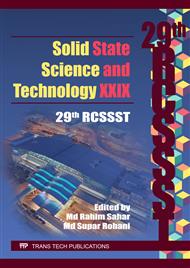[1]
T.H. Han, Y. Lee, M.R. Choi, S. Woo, S. Bae, B.H. Hong, J.H. Ahn, T.W. Lee, Extremely efficient flexible organic light-emitting diodes with modified graphene anode, Nature Photonics, 16 (2012) 105-10.
DOI: 10.1038/nphoton.2011.318
Google Scholar
[2]
B.S. Ong, C. Li, Y. Li, Y. Wu, R. Loutfy, Stable, solution-processed, high-mobility ZnO thin-film transistors, Journal of the American Chemical Society. 129 (2007) 2750-1.
DOI: 10.1021/ja068876e
Google Scholar
[3]
A. Kim, Y. Won, K. Woo, C. Kim, J. Moon, Highly transparent low resistance ZnO/Ag nanowire/ZnO composite electrode for thin film solar cells, ACS nano. 7 (2013) 1081-91.
DOI: 10.1021/nn305491x
Google Scholar
[4]
X. W. Sun, J. Z. Huang, J. X. Wang, Z. Xu, A ZnO nanorod inorganic/organic heterostructure light-emitting diode emitting at 342 nm, Nano Letters. 123 (2012)1219-23.
DOI: 10.1021/nl080340z
Google Scholar
[5]
E. D. Gaspera, M. Bersani, M. Cittadini, M. Guglielmi, D. Pagani, R. Noriega, S. Mehra, A. Salleo, A. Martucci, Low-temperature processed Ga-doped ZnO coatings from colloidal inks, Journal of the American Chemical Society. 135(2013)3439-48.
DOI: 10.1021/ja307960z
Google Scholar
[6]
W. J. Jeong, S. K. Kim, G. C. Park, Preparation and characteristic of ZnO thin film with high and low resistivity for an application of solar cell, Thin Solid Films. 506 (2006)180-3.
DOI: 10.1016/j.tsf.2005.08.213
Google Scholar
[7]
S. Ishibashi, Y. Higuchi, Y. Ota, K. Nakamura, Low resistivity indium–tin oxide transparent conductive films. Effect of introducing H2O gas or H2 gas during direct current magnetron sputtering, Journal of Vacuum Science & Technology A. 8 (1990).
DOI: 10.1016/0042-207x(91)90990-z
Google Scholar
[8]
P. L. Tat, K. Deraman, R. Hussin, W. Shamsuri, W. Nurulhuda, Z. Ibrahim, The Structural and Surface Morphology of Annealed ZnO Films, InAdvanced Materials Research. 903 (2014) 73-77.
DOI: 10.4028/www.scientific.net/amr.903.73
Google Scholar
[9]
H. Noorik, K. B. Deraman, ZnO nanostructure: A review on their growth and structural properties by thermal evaporate and Chemical Vapor Deposition methods.
Google Scholar
[10]
C. Li, M. Furuta, T. Matsuda, T. Hiramatsu, H. Furuta, T. Hira, Effects of substrate on the structural, electrical and optical properties of Al-doped ZnO films prepared by radio frequency magnetron sputtering, Thin Solid Films. 517 (2009) 3265-8.
DOI: 10.1016/j.tsf.2008.11.103
Google Scholar
[11]
H. S. Kang, J. S. Kang, S. S. Pang, E. S. Shim, S. Y. Lee, Variation of light emitting properties of ZnO thin films depending on post-annealing temperature, Materials Science and Engineering: B. 120 (2003) 313-6.
DOI: 10.1016/s0921-5107(02)00730-4
Google Scholar
[12]
S. W. Kuo, W. C. Chen, F. I. Lai, C. P. Cheng, H. C. Kuo, S. C. Wang, W. F. Hsieh, Effects of doping concentration and annealing temperature on properties of highly-oriented Al-doped ZnO films, Journal of crystal growth. 287(2006) 78-84.
DOI: 10.1016/j.jcrysgro.2005.10.047
Google Scholar
[13]
S. S. Kumar, P. Venkateswarlu, V. R. Rao, G. N. Rao, Synthesis, characterization and optical properties of zinc oxide nanoparticles, International Nano Letters. 3 (2013)1-6.
DOI: 10.1186/2228-5326-3-30
Google Scholar
[14]
J. H. Lee, K. H. Ko, B. O. Park, Electrical and optical properties of ZnO transparent conducting films by the sol–gel method, Journal of Crystal Growth. 247 (2003) 119-25.
DOI: 10.1016/s0022-0248(02)01907-3
Google Scholar
[15]
K. E. Lee, M. Wang, E. J. Kim, S. H. Hahn, Structural, electrical and optical properties of sol–gel AZO thin films, Current Applied Physics. 9 (2009)683-7.
DOI: 10.1016/j.cap.2008.06.006
Google Scholar


